
Paderne is a village and civil parish in the municipality (concelho) of Albufeira, in the Portuguese region of Algarve. The population in 2011 was 3,304, in an area of 52.56 km².
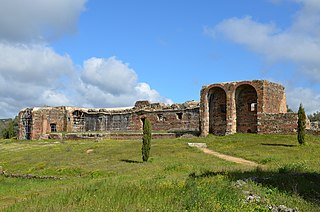
The Roman ruins of São Cucufate is a Romanesque archaeological site, located on the ruins of a Roman-era agricultural farm in the civil parish of Vila de Frades, in the municipality of Vidigueira, in the southern Alentejo, Portugal. The convent, which dates back to Middle Ages, was dedicated to the martyred saint Cucuphas.

The Roman ruins of Villa Cardillio is an archaeological site located in central Portugal. Situated in the rural civil parish of Santa Maria, it is located approximately 3 km from the centre of the municipal seat of Torres Novas. Receiving its name from a mosaic pavement onsite, the specific translation of piece is still unclear, but assumed that the site was owned by a couple. The ruins were first excavated in 1962, yielding hundreds of coins and well as ceramics, bronze works, Assyrian and Egyptian glass works. Also revealed were some jewellery and a statue of Eros.
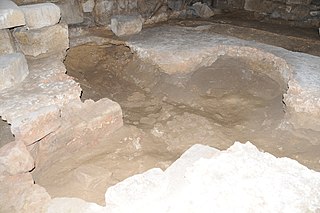
The Monastery of Dumio, is a former paleo-Christian monastery in the civil parish of Dume, municipality of Braga, in northwestern Portugal. Originally a Roman villa, it was the base of a basilica by Suebi tribes, and later Christian monastery headed by Martin of Braga in the 6th century. The re-discovery of the Roman ruins in the late 20th century resulted in archaeological excavations that unearthed its former use.
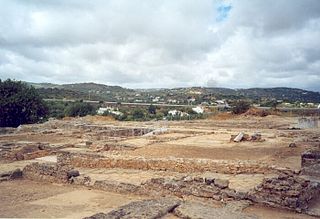
Estoi is a former civil parish in the municipality of Faro, in the Algarve, Portugal. In 2013, the parish merged into the new parish Conceição e Estoi. The parish, which includes an area of approximately 46.55 square kilometres (17.97 sq mi), had a population of 3,538 at the 2001 census. The name of the parish, which was formerly spelled "Estói", was changed in 2004.
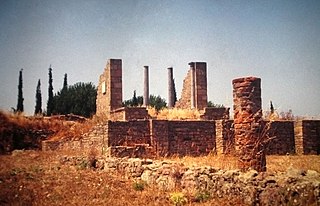
Miróbriga is an ancient Roman town located near the village and civil parish of Santiago do Cacém, in the municipality of the same name in the south-west of Portugal. Archeology revealed that the town occupied the site of an ancient Iron Age settlement that existed since the 9th century B.C.
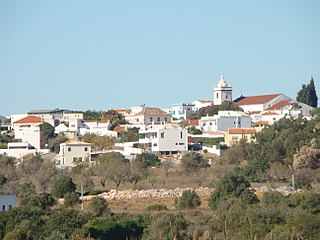
Mexilhoeira Grande is a civil parish in the municipality (concelho) of Portimão in the southern Portuguese region of the Algarve. The population in 2011 was 4,029, in an area of 91.15 km².
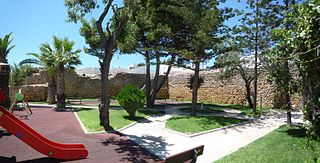
The Castle of Alvor is a medieval castle in the civil parish of Alvor, in the Portuguese district of Faro: considered to be a significant military monument associated with the nearby Castle of Silves.

The Roman Ruins of Cerro da Vila are the remnants of a historical villa in the Algarve region of southern Portugal. Its vestiges lie in the vicinity of the resort and marina of Vilamoura, in the civil parish of Quarteira, municipality of Loulé Municipality.

The Castle of Alfeizerão, is a Portuguese medieval castle in civil parish of Alfeizerão, in the municipality of Alcobaça, in the district of Leiria.

The Roman ruins of Santo Andre de Almoçageme is a Portuguese archaeological site located in the rural civil parish of Colares, in the municipality of Sintra. It includes a group of structures with typological, stylistic or historic value, whose structural elements are worthy of preservation.

The Roman ruins of Casais Velhos are the remains of a Roman town, in the municipality of Cascais, Lisbon District, Portugal that included baths, two cemeteries, remains of a wall and ceramic artifacts.

The Roman villa of Alto da Cidreira is a Roman villa in the civil parish of Alcabideche, municipality of Cascais, in the Lisbon District of Portugal. Although known since the 1890s, this site has largely been neglected by archaeologists, resulting in destruction of artefacts, including Roman era mosaics, a bath complex and an olive oil cellar.
The Roman villa of Outeiro de Polima is a Roman villa in the civil parish of São Domingos de Rana, in the Portuguese municipality of Cascais, dating from the 1st to 6th centuries AD.
The Prehistoric Rock-Art Site Pala Pinta is a Paleolithic-era rock-art site, recognized for cave paintings in the Portuguese municipality of Alijó, in the civil parish of Carlão e Amieiro.

The Roman villa of Freiria is a Roman villa in the civil parish of São Domingos de Rana, in the Portuguese municipality of Cascais.

Sebastião Phillipes Martins Estácio da Veiga, was a Portuguese archeologist and writer, known for having discovered several important archaeological sites in the Algarve and having made advancements in the study of several others also found in the region and in the Alentejo.
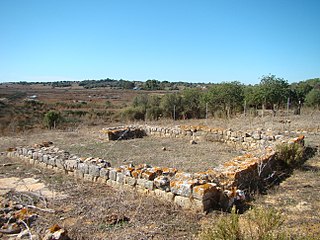
Abicada is the name of Roman ruins in Mexilhoeira Grande, to the north of the civil parish of Alvor, municipality of Portimão, in Algarve region, Portugal. In Roman times it was in the colony of Ipses, in the Roman province of Lusitania, which was authorized to mint currency, and where a woman named Pompeia Exoce looked after the burial of her grandson. Portimão, to east-southeast, known as Portus Magnus at the time, was an important Roman commercial port when the Roman villa was built.

The Roman Ruins of Pisões, is an important Roman villa rustica located in the civil parish of Beja in the municipality of Beja, in the Portuguese Alentejo, classified as a Imóvel de Interesse Público.
The Villa Lusitano-Romana de Torre de Palma, sometimes Villa Cardillio or Vila Cardílio is a Roman villa near Monforte in Portugal, which was in Roman times part of the province of Lusitania. It is considered one of the largest in the Iberian Peninsula. The prosperity of these latifundia in the region is often evidenced by shrines in the courtyard. In addition to the extensive living areas, a basilica and a seven-roomed baptistery have been uncovered in Torre de Palma.































